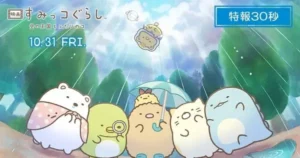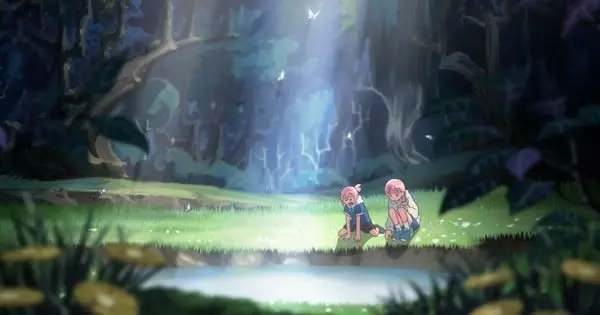Panasonic has released a 34-minute English-subtitled anime, “The Land of Nomo,” to promote its pavilion at the upcoming Osaka World Expo 2025. This original animation, produced by Panasonic Visuals Co., Ltd. and monofilmo Inc., based on a story by Hiroaki Kubo, serves as an introduction to the themes and experiences visitors can expect at the “The Land of Nomo” pavilion.
A Glimpse into “The Land of Nomo”
The anime is available for streaming on YouTube and offers a preview of the pavilion’s concept: a mysterious land that mirrors one’s thoughts and feelings, promising new adventures and discoveries hidden deep within the heart.
Storyline and Characters
The story revolves around Sora, a young girl who has lost her ability to sing due to a past incident. Along with her younger brother, Daichi, she stumbles upon a mysterious pond called Kagamiike and finds herself transported to the enchanting world of Nomo. There, they meet Rococo, an unusual girl who guides them on an adventure, helping Sora confront her hidden emotions.
- Sora: Voiced by Kana Ichinose, Sora is a girl struggling with her inability to sing.
- Daichi: Voiced by Megumi Han, Daichi is Sora’s younger brother.
- Rococo: Voiced by Aoi Yūki, Rococo is a mysterious girl who appears in the land of Nomo.
Music
The anime features the song “Yume wa Tsubasa” (Dreams are Wings), performed by Sakurako Ōhara, with lyrics written by Yukinojo Mori and composition by Takayuki Hattori.
Panasonic’s Pavilion at Osaka World Expo 2025: “The Land of Nomo”
Panasonic Group will present a pavilion titled “The Land of NOMO” at Expo 2025 Osaka, Kansai, Japan. The Expo will take place on the man-made Yumeshima island in Osaka Bay from April 13 to October 13, 2025.
Concept
The pavilion’s concept revolves around unlocking the imagination and creativity of children, encouraging them to perceive the world in new ways. The core idea is that one’s perception of things depends on their state of mind, suggesting a connection between inner thoughts and the external world. The pavilion aims to inspire children to unleash their imagination and creation, with the potential to change the world.
The concept is: “Set your heart and mind free, and the world will open up”.
Experiential Zones
The “Unlock Experience Area” of “The Land of NOMO” offers immersive experiences using technologies related to light, video, sound, and air. Children can engage with a 3D sound system, a 360° video system, haptics involving vibrations and wind, and a “Mist Wall” made of extremely fine mist particles.
The Unlock Experience Area is 922 m2, with a supporting exhibition area, “Earth” (165 m2).
The Unlock Experience Area is split into four zones:
- ZONE1: Deep within the Mirror Pond: Visitors’ senses are sharpened cross-modally through three-dimensional sound, visuals, and vibrations, allowing them to fully perceive the world of wind, water, light and life.
- ZONE2: NOMO Forest: Children discover “crystals” within a forest full of life and energy, which respond with light, sound, and wind when the crystals are held up.
- ZONE3: The Valley of Ancient Trees: Visitors’ senses and future potential are projected as a story, and butterflies are released from the crystals, leading the children beyond the Mist Waterfall.
- ZONE4: Into the Wide Open Sky: Visitors muster the courage to pass through the Mist Waterfall, and the butterflies released by each child in ZONE3 ride the wind created by the children, producing sound and eventually resonating with the surrounding butterflies. Images are projected in a 360° space by 21 high-brightness projectors, and sound and visuals interact three-dimensionally.
Participants receive an “Unlock Card” that reflects their experience results when they return the crystal device.
Sustainability Efforts
Panasonic emphasizes sustainability in the construction of “The Land of NOMO,” utilizing recycled materials such as iron, copper, and glass collected from used home appliances. Recycled iron accounts for approximately 98% (97.1 tons) of the main columns and beams, recycled copper amounts to approximately 1.2 tons used in the main trunk cables, and recycled glass from around 9,200 drum-type washer-dryers was used for exterior paving blocks.
The pavilion’s lighting will utilize hydrogen derived from zero-carbon electricity. A light-up ceremony was held on March 1st, featuring a display of lights and mist on the pavilion’s facade. The light-up display is managed through Panasonic Group’s cloud-based lighting technology “YOI-en,” creating a magical atmosphere with 75 full-color LED floodlights and audio equipment.
Panasonic is conducting co-creation activities with children and students, reflecting these efforts in the creation of the pavilion through the “NOMO no Co-Project”. A light and sound display created by students and elementary school children will be featured.
A prototype of a “glass-type perovskite solar cell” designed by artist Kaede Wajima, in collaboration with HERALBONY Co., Ltd., is on display outdoors.
Facial Authentication
DNP and Panasonic Connect are introducing an admission system using facial authentication for Expo-related parties. The system combines facial authentication and QR authentication to achieve smooth and strict identity verification.
Osaka World Expo: A Look Back
The 2025 World Expo marks the second time Osaka has hosted this event, following Expo ’70, which took place 55 years prior. A remnant of that expo is the famous Tower of the Sun, a landmark that has appeared in various stories and media.
Other attractions at the Expo include a 3D CG anime short titled “Neo Atom Tanjō” (The Birth of Neo Astro Boy ), based on Osamu Tezuka ‘s Astro Boy and Black Jack manga and anime, the “Gundam Next Future Pavilion,” and Shōji Kawamori’s hybrid virtual reality short film “499-Byō Watashi no Gattai” (“499 Seconds: My Gattai”).
Panasonic’s History with Anime
Panasonic’s involvement with animation dates back several decades.
In the 1960s, Matsushita Electric Industrial Company (later to be known as Panasonic) sponsored Terebi Doga’s “Marine Boy” anime series.
Corporate Social Responsibility
Panasonic is committed to sustainability and social responsibility. The company aims to address social problems, create better ways to live, and develop a society in which humans are happy worldwide through its business and corporate citizenship activities.
Panasonic has a long-term environmental vision called “Panasonic GREEN IMPACT,” to contribute to reducing CO2 emissions both in business and in society.
Panasonic Industry promotes CSR activities based on the Basic Business Philosophy of the Panasonic Group, focusing on human rights, labor, health and safety, environmental protection, ethics, quality and product safety, BCP and BCM, and supply chain management.
Conclusion
Panasonic’s “The Land of Nomo” pavilion at the Osaka World Expo 2025 promises to be an immersive and imaginative experience for children, encouraging them to unlock their creativity and see the world in new ways. The release of the anime provides a glimpse into this world, highlighting the themes and technologies that will be featured at the pavilion. With a focus on sustainability and social responsibility, Panasonic aims to inspire a brighter future for all.









